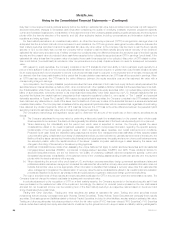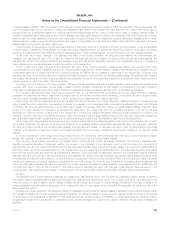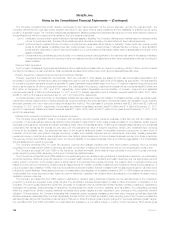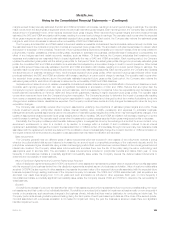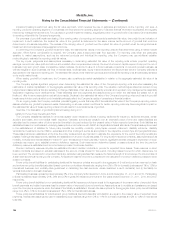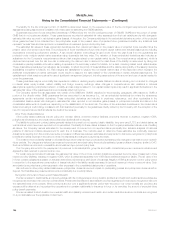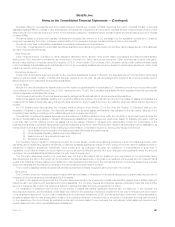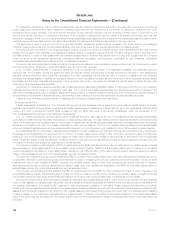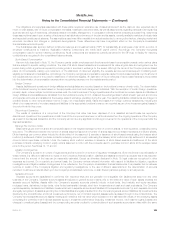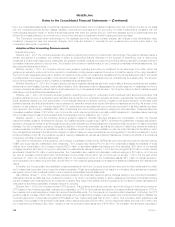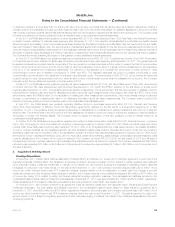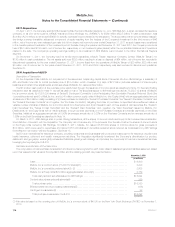MetLife 2011 Annual Report Download - page 110
Download and view the complete annual report
Please find page 110 of the 2011 MetLife annual report below. You can navigate through the pages in the report by either clicking on the pages listed below, or by using the keyword search tool below to find specific information within the annual report.MetLife, Inc.
Notes to the Consolidated Financial Statements — (Continued)
The liability for the life contingent portion of GMWB is determined based on the expected value of the life contingent payments and expected
assessments using assumptions consistent with those used for estimating the GMDB liabilities.
Guarantees accounted for as embedded derivatives in PABs include the non life-contingent portion of GMWB, GMAB and the portion of certain
GMIB that do not require annuitization. These guarantees are recorded at estimated fair value separately from the host variable annuity with changes in
estimated fair value reported in net derivative gains (losses). At inception, the Company attributes to the embedded derivative a portion of the projected
future guarantee fees to be collected from the policyholder equal to the present value of projected future guaranteed benefits. Any additional fees
represent “excess” fees and are reported in universal life and investment-type product policy fees.
The estimated fair values of these embedded derivatives are then determined based on the present value of projected future benefits minus the
present value of projected future fees. The projections of future benefits and future fees require capital market and actuarial assumptions including
expectations concerning policyholder behavior. A risk neutral valuation methodology is used under which the cash flows from the guarantees are
projected under multiple capital market scenarios using observable risk free rates. The valuation of these embedded derivatives also includes an
adjustment for the Company’s nonperformance risk and risk margins related to non-capital market inputs. The nonperformance adjustment, which is
captured as a spread over the risk free rate in determining the discount rate to discount the cash flows of the liability, is determined by taking into
consideration publicly available information relating to spreads in the secondary market for MetLife, Inc.’s debt, including related credit default swaps.
These observable spreads are then adjusted, as necessary, to reflect the priority of these liabilities and the claims paying ability of the issuing insurance
subsidiaries compared to MetLife, Inc. Risk margins are established to capture the non-capital market risks of the instrument which represent the
additional compensation a market participant would require to assume the risks related to the uncertainties in certain actuarial assumptions. The
establishment of risk margins requires the use of significant management judgment, including assumptions of the amount and cost of capital needed to
cover the guarantees.
These guarantees may be more costly than expected in volatile or declining equity markets. Market conditions including, but not limited to, changes
in interest rates, equity indices, market volatility and foreign currency exchange rates, changes in nonperformance risk, variations in actuarial
assumptions regarding policyholder behavior, mortality and risk margins related to non-capital market inputs may result in significant fluctuations in the
estimated fair value of the guarantees that could materially affect net income.
The Company ceded the risk associated with certain of the GMIB and GMWB described in the preceding paragraphs. With respect to GMIB, a
portion of the directly written GMIB guarantees that are accounted for as insurance (i.e., not as embedded derivatives) but where the reinsurance
agreements contain embedded derivatives. These embedded derivatives are included in premiums, reinsurance, and other receivables in the
consolidated balance sheet with changes in estimated fair value reported in net derivative gains (losses) or policyholder benefits and claims in the
consolidated statements of operations, depending on the classification of the direct risk. The value of the embedded derivatives on the ceded risk is
determined using a methodology consistent with that described previously for the guarantees directly written by the Company with the exception of the
input for nonperformance risk that reflects the credit of the reinsurer.
Other Policy-Related Balances
Other policy-related balances include policy and contract claims, unearned revenue liabilities, premiums received in advance, negative VOBA,
policyholder dividends due and unpaid and policyholder dividends left on deposit.
The liability for policy and contract claims generally relates to incurred but not reported death, disability, long-term care (“LTC”) and dental claims, as
well as claims which have been reported but not yet settled. The liability for these claims is based on the Company’s estimated ultimate cost of settling
all claims. The Company derives estimates for the development of incurred but not reported claims principally from actuarial analyses of historical
patterns of claims and claims development for each line of business. The methods used to determine these estimates are continually reviewed.
Adjustments resulting from this continuous review process and differences between estimates and payments for claims are recognized in policyholder
benefits and claims expense in the period in which the estimates are changed or payments are made.
The unearned revenue liability relates to universal life-type and investment-type products and represents policy charges for services to be provided in
future periods. The charges are deferred as unearned revenue and amortized using the product’s estimated gross profits and margins, similar to DAC.
Such amortization is recorded in universal life and investment-type product policy fees.
The Company accounts for the prepayment of premiums on its individual life, group life and health contracts as premium received in advance and
applies the cash received to premiums when due.
For certain acquired blocks of business, the estimated fair value of the in-force contract obligations exceeded the book value of assumed in-force
insurance policy liabilities, resulting in negative VOBA, which is presented separately from VOBA as an additional insurance liability. The fair value of the
in-force contract obligations is based on actuarial determined projections by each block of business. Negative VOBA is amortized over the policy period
in proportion to the approximate consumption of losses included in the liability usually expressed in terms of insurance in-force or account value. Such
amortization is recorded as a contra-expense in other expenses in the consolidated statements of operations.
Also included in other policy-related balances are policyholder dividends due and unpaid on participating policies and policyholder dividends lefton
deposit. Such liabilities are presented at amounts contractually due to policyholders.
Recognition of Insurance Revenue and Related Benefits
Premiums related to traditional life and annuity policies with life contingencies and long-duration accident and health and credit insurance policies are
recognized as revenues when due from policyholders. Policyholder benefits and expenses are provided against such revenues to recognize profits over
the estimated lives of the policies. When premiums are due over a significantly shorter period than the period over which benefits are provided, any
excess profit is deferred and recognized into operations in a constant relationship to insurance in-force or, for annuities, the amount of expected future
policy benefit payments.
Premiums related to short-duration non-medical health and disability, accident and health, and certain credit life insurance contracts are recognized
on a pro rata basis over the applicable contract term.
106 MetLife, Inc.


